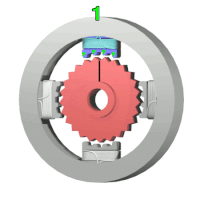This article has multiple issues. Please help improve it or discuss these issues on the talk page. (Learn how and when to remove these messages)
|

Frame 2: The top electromagnet (1) is turned off, and the right electromagnet (2) is energized, pulling the teeth into alignment with it. This results in a rotation of 3.6° in this example.
Frame 3: The bottom electromagnet (3) is energized; another 3.6° rotation occurs.
Frame 4: The left electromagnet (4) is energized, rotating again by 3.6°. When the top electromagnet (1) is again enabled, the rotor will have rotated by one tooth position; since there are 25 teeth, it will take 100 steps to make a full rotation in this example.
A stepper motor, also known as step motor or stepping motor,[1] is a Brushless DC electric motor that rotates in a series of small and discrete angular steps.[2] Stepper motors can be set to any given step position without needing a position sensor for feedback. The step position can be rapidly increased or decreased to create continuous rotation, or the motor can be ordered to actively hold its position at one given step. Motors vary in size, speed, step resolution, and torque.
Switched reluctance motors are very large stepping motors with a reduced pole count. They generally employ closed-loop commutators.
- ^ Clarence W. de Silva. Mechatronics: An Integrated Approach (2005). CRC Press. p. 675. "The terms stepper motor, stepping motor, and step motor are synonymous and are often used interchangeably."
- ^ Escudier, Marcel; Atkins, Tony (2019). A Dictionary of Mechanical Engineering. doi:10.1093/acref/9780198832102.001.0001. ISBN 978-0-19-883210-2.